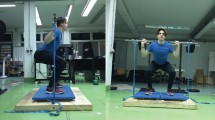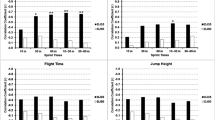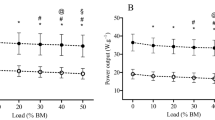Abstract
Purpose
To study the effect of a countermovement on the lower limb force–velocity (F–v) mechanical profile and to experimentally test the influence of F–v mechanical profile on countermovement jump (CMJ) performance, independently from the effect of maximal power output (P max).
Methods
Fifty-four high-level sprinters and jumpers performed vertical maximal CMJ and squat jump (SJ) against five to eight additional loads ranging from 17 to 87 kg. Vertical ground reaction force data were recorded (1,000 Hz) and used to compute center of mass vertical displacement. For each condition, mean force, velocity, and power output were determined over the entire push-off phase of the best trial, and used to determine individual linear F–v relationships and P max. From a previously validated biomechanical model, the optimal F–v profile maximizing jumping performance was determined for each subject and used to compute the individual mechanical F–v imbalance (Fv IMB) as the difference between actual and optimal F–v profiles.
Results
A multiple regression analysis clearly showed (r 2 = 0.952, P < 0.001, SEE 0.011 m) that P max, Fv IMB and lower limb extension range (h PO) explained a significant part of the interindividual differences in CMJ performance (P < 0.001) with positive regression coefficients for P max and h PO and a negative one for Fv IMB.
Conclusion
Compared to SJ, F–v relationships were shifted to the right in CMJ, with higher P max, maximal theoretical force and velocity (+35.8, 20.6 and 13.3 %, respectively). As in SJ, CMJ performance depends on Fv IMB, independently from the effect of P max, with the existence of an individual optimal F–v profile (Fv IMB having an even larger influence in CMJ).



Similar content being viewed by others
Abbreviations
- SJ:
-
Squat jump
- CMJ:
-
Countermovement jump
- F–v :
-
Force–velocity
- P–v :
-
Power–velocity
- P max :
-
Maximal power output
- \( \overline{F} \) :
-
Mean force
- \( \overline{v} \) :
-
Mean velocity
- \( \overline{P} \) :
-
Mean power
- h PO :
-
Vertical distance covered by the CM during push-off
- Fv IMB :
-
F–v imbalance
- S Fv :
-
F–v profile
- S Fvopt:
-
Optimal F–v profile
References
Bobbert MF (2012) Why is the force–velocity relationship in leg press tasks quasi-linear rather than hyperbolic? J Appl Physiol. doi:10.1152/japplphysiol.00787.2011
Bobbert MF, Casius LJ (2005) Is the effect of a countermovement on jump height due to active state development? Med Sci Sports Exerc 37(3):440–446
Bobbert MF, Gerritsen KG, Litjens MC, van Soest AJ (1996) Why is countermovement jump height greater than squat jump height? Med Sci Sports Exerc 28(11):1402–1412
Bosco C, Komi PV (1979) Potentiation of the mechanical behavior of the human skeletal muscle through prestretching. Acta Physiol Scand 106(4):467–472
Bosco C, Viitasalo JT, Komi PV, Luhtanen P (1982) Combined effect of elastic energy and myoelectrical potentiation during stretch-shortening cycle exercise. Acta Physiol Scand 114(4):557–565
Bosco C, Luhtanen P, Komi PV (1983) A simple method for measurement of mechanical power in jumping. Eur J Appl Physiol Occup Physiol 50(2):273–282
Bosco C, Belli A, Astrua M, Tihanyi J, Pozzo R, Kellis S, Tsarpela O, Foti C, Manno R, Tranquilli C (1995) A dynamometer for evaluation of dynamic muscle work. Eur J Appl Physiol Occup Physiol 70(5):379–386
Canavan PK, Vescovi JD (2004) Evaluation of power prediction equations: peak vertical jumping power in women. Med Sci Sports Exerc 36(9):1589–1593
Comfort P, Stewart A, Bloom L, Clarkson B (2014) Relationships between strength, sprint and jump performance in well trained youth soccer players. J Strength Cond Res 28(1):173–177. doi:10.1519/JSC.0b013e318291b8c7
Cormie P, McCaulley GO, Triplett NT, McBride JM (2007) Optimal loading for maximal power output during lower-body resistance exercises. Med Sci Sports Exerc 39(2):340–349. doi:10.1249/01.mss.0000246993.71599.bf
Cormie P, McGuigan MR, Newton RU (2011) Developing maximal neuromuscular power: part 1—biological basis of maximal power production. Sports Med 41(1):17–38
Cronin J, Hansen KT (2005) Strength and power predictors of sports speed. J Strength Cond Res 19(2):349–357
Cronin J, Sleivert G (2005) Challenges in understanding the influence of maximal power training on improving athletic performance. Sports Med 35(3):213–234
Frost DM, Cronin J, Newton RU (2010) A biomechanical evaluation of resistance: fundamental concepts for training and sports performance. Sports Med 40(4):303–326
Hoffman JR, Maresh CM, Newton RU, Rubin MR, French DN, Volek JS, Sutherland J, Robertson M, Gomez AL, Ratamess NA, Kang J, Kraemer WJ (2002) Performance, biochemical, and endocrine changes during a competitive football game. Med Sci Sports Exerc 34(11):1845–1853. doi:10.1249/01.MSS.0000035373.26840.F8
Hoffman JR, Ratamess NA, Cooper JJ, Kang J, Chilakos A, Faigenbaum AD (2005) Comparison of loaded and unloaded jump squat training on strength/power performance in college football players. J Strength Cond Res 19(4):810–815
Klavora P (2000) Vertical-jump tests: a critical review. Strength Cond 22:70–75
Maffiuletti NA, Dugnani S, Folz M, Di Pierno E, Mauro F (2002) Effect of combined electrostimulation and plyometric training on vertical jump height. Med Sci Sports Exerc 34(10):1638–1644
Markström JL, Olsson CJ (2013) Countermovement jump peak force relative to body weight and jump height as predictors for sprint running performances: (in)homogeneity of track and field athletes? J Strength Cond Res 27(4):944–953
McMaster DT, Gill N, Cronin J, McGuigan M (2013) Force–velocity–power assessment in semi-professional rugby union players. J Strength Cond Res. doi:10.1519/JSC.0b013e3182a1da46
Rahmani A, Viale F, Dalleau G, Lacour JR (2001) Force/velocity and power/velocity relationships in squat exercise. Eur J Appl Physiol 84(3):227–232
Rahmani A, Locatelli E, Lacour JR (2004) Differences in morphology and force/velocity relationship between Senegalese and Italian sprinters. Eur J Appl Physiol 91(4):399–405
Samozino P, Morin JB, Hintzy F, Belli A (2008) A simple method for measuring force, velocity and power output during squat jump. J Biomech 41(14):2940–2945
Samozino P, Morin JB, Hintzy F, Belli A (2010) Jumping ability: a theoretical integrative approach. J Theor Biol 264(1):11–18. doi:10.1016/j.jtbi.2010.01.021
Samozino P, Rejc E, Di Prampero PE, Belli A, Morin JB (2012) Optimal force–velocity profile in ballistic movements—altius: citius or fortius? Med Sci Sports Exerc 44(2):313–322. doi:10.1249/MSS.0b013e31822d757a
Samozino P, Edouard P, Sangnier S, Brughelli M, Gimenez P, Morin JB (2013) Force–velocity profile: imbalance determination and effect on lower limb ballistic performance. Int J Sports Med. doi:10.1055/s-0033-1354382
Vandewalle H, Peres G, Heller J, Panel J, Monod H (1987) Force–velocity relationship and maximal power on a cycle ergometer. Correlation with the height of a vertical jump. Eur J Appl Physiol Occup Physiol 56(6):650–656
Vanezis A, Lees A (2005) A biomechanical analysis of good and poor performers of the vertical jump. Ergonomics 48(11–14):1594–1603
Winter EM (2005) Jumping: power or impulse. Med Sci Sports Exerc 37(3):523–524
Wisloff U, Castagna C, Helgerud J, Jones R, Hoff J (2004) Strong correlation of maximal squat strength with sprint performance and vertical jump height in elite soccer players. Br J Sports Med 38(3):285–288
Yamauchi J, Ishii N (2007) Relations between force–velocity characteristics of the knee-hip extension movement and vertical jump performance. J Strength Cond Res 21(3):703–709
Acknowledgments
The authors thank coaches and athletes for their “explosive” and “powerful” implication in the protocol. The authors declare that they have no conflict of interest.
Author information
Authors and Affiliations
Corresponding author
Additional information
Communicated by Michael Lindinger.
Rights and permissions
About this article
Cite this article
Jiménez-Reyes, P., Samozino, P., Cuadrado-Peñafiel, V. et al. Effect of countermovement on power–force–velocity profile. Eur J Appl Physiol 114, 2281–2288 (2014). https://doi.org/10.1007/s00421-014-2947-1
Received:
Accepted:
Published:
Issue Date:
DOI: https://doi.org/10.1007/s00421-014-2947-1




